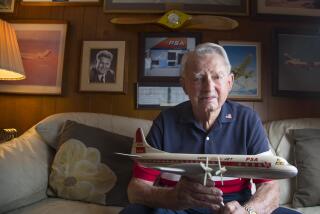J. Leland Atwood, Rockwell Aviation Pioneer, Dead at 94
- Share via
J. Leland “Lee” Atwood, the former head of North American Rockwell Corp. who spearheaded the development of innovative aircraft from the P-51 bomber to the space shuttle, has died. He was 94.
Atwood, former president and chief executive of North American Aviation Inc., which later merged with Rockwell and is now a part of Boeing Co., died Friday at St. John’s Hospital in Santa Monica, the company said Sunday.
Don H. Davis, current chairman of Rockwell International Corp., called Atwood “a great American,” and former Chairman Donald R. Beall praised him as “a great source of inspiration to me and to all of Rockwell’s engineers.”
Atwood was credited with creating the P-51 Mustang fighter, which accounted for almost half the enemy aircraft downed in the European theater during World War II.
Pilot Chuck Yeager, later famous for breaking the sound barrier, shot down five German planes in a single day during World War II while flying a P-51. He described the craft as “the best American fighter in the war, equal to anything the Germans put up against her.”
Atwood also helped design and produce the B-25 Mitchell medium bomber, which Col. Jimmy Doolittle used in 1942 for his legendary attack on Tokyo.
After the war, Atwood turned his attention to the company’s future. He created its aerophysics laboratory, which led to the development of the Apollo spacecraft used to put astronauts on the moon and the space shuttles in use today.
He was also instrumental in Rockwell’s development of the F-100 Super Sabre, X-15 rocket plane and B-1 bomber, which, along with the space shuttle, each received Collier trophies for achievements in aeronautics and astronautics.
Atwood was a hands-on aviation pioneer for 42 years, beginning when he joined the Army Air Corps at Dayton’s Wright Field straight out of college in 1928.
In 1930, Atwood moved to Santa Monica as a design engineer with Douglas Aircraft Co. Four years later, he switched to North American Aviation as chief engineer and within nine weeks was a vice president. He was named assistant general manager in 1938 and first vice president in 1941 and was elected president in 1948. He became chief executive in 1960 and chairman two years later.
Atwood retired in 1970 as president and chief executive of North American Rockwell Corp., three years after it was formed by the merger of El Segundo-based North American Aviation and Pittsburgh-based Rockwell-Standard Corp. The retirement, when Atwood was 65, was seen at the time as an assumption of company control by Rockwell officials over their North American Aviation counterparts.
But Robert Anderson, Atwood’s immediate successor, on Sunday credited Atwood for helping to “shape the initiatives that resulted in Rockwell’s diversification and expansion into commercial and military electronics, guided missile systems, and ultimately, the company’s role in history’s greatest technological triumph, mankind’s first steps on the moon.”
During his tenure in the aerospace industry, Atwood prodded government and civilian officials alike to embrace nuclear power and to surpass the Soviet Union in the space race. He also worked on early Southern California efforts to combat air pollution.
An engineer at heart, Atwood insisted throughout the Cold War that engineers were the nation’s primary defense. Trying to maintain military supremacy “man for man and gun for gun” against countries with exploding population, he told The Times in a 1955 interview, could bankrupt the United States.
“There appears to be only one course that will provide security without economic ruin,” he said, “and that is to maintain qualitative superiority. . . . The research, design and industrial engineering necessary to provide superior weapon quality on a continuing basis is the most challenging problem engineers have to face. It is literally a problem of survival.”
Among Atwood’s myriad honors were the Presidential Certificate of Merit in 1948 for his war efforts, Italy’s Commander of Merit decoration in 1955 for contributions to aviation, NASA’s Public Service award in 1969 for his work with the Apollo 8 moon landing, and USC’s California Pioneers in Engineering award in 1994.
The Walton, Ky., native earned a bachelor of arts degree from Hardin-Simmons University and a bachelor of science in engineering from the University of Texas.
Atwood is survived by his wife, Patricia.
More to Read
Inside the business of entertainment
The Wide Shot brings you news, analysis and insights on everything from streaming wars to production — and what it all means for the future.
You may occasionally receive promotional content from the Los Angeles Times.









